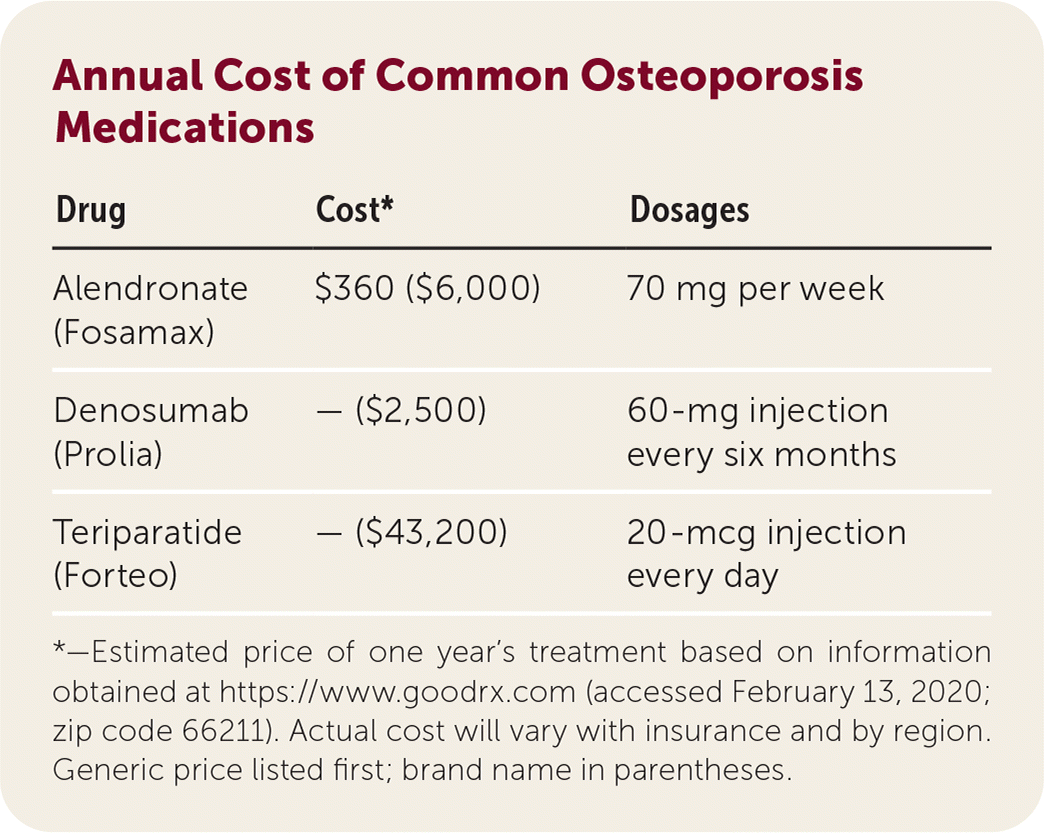
Am Fam Physician. 2020;101(6):370-372
Author disclosure: No relevant financial affiliations.
Case Scenario
Ms. M is an 82-year-old white woman who lives alone at home. She has a body mass index of 20 kg per m2 and describes her health as good. However, she takes medications for hypertension and has mild chronic obstructive pulmonary disease attributed to a long-term half-a-pack-per-day smoking habit. She has received several short courses of corticosteroids for acute chronic obstructive pulmonary disease exacerbations during the past five years. She does not drink alcohol and has not had any fractures. She is relatively sedentary and uses a walker outside her home. Using the combined Lee Schonberg Index (https://eprognosis.ucsf.edu/leeschonberg.php), her estimated life expectancy is five to seven years.1 Her Fracture Risk Assessment Tool (https://www.sheffield.ac.uk/FRAX/) score, calculated without a dual energy x-ray absorptiometry (DEXA) measurement, indicates that she has a 26% chance of a hip fracture during the next 10 years.2 Should Ms. M be prescribed medication to prevent osteoporotic fractures?
Clinical Commentary
Vertebral fractures can be painful; however, most are asymptomatic and discovered incidentally in 20% of women 80 to 89 years of age.3 Older adults with hip fractures, however, often require skilled nursing care and are unable to return home. In a survey of older women, 80% reported preferring death over a hip fracture leading to hospitalization.4 Falls cause more than 95% of hip fractures, and measures to reduce the risk of falls should be encouraged even if medication is prescribed.5

| Fall prevention and lifestyle modifications are important in preventing osteoporotic fractures. |
| If possible, eliminate medications with adverse effects that can increase fall risk. |
| Estimated life expectancy and not chronologic age should be considered when assessing the need for osteoporosis therapy. |
| Document the start of treatment in the patient's problem list, and advise the patient that the U.S. Food and Drug Administration recommends stopping pharmacologic treatment after five years. |
The American College of Physicians published an evidence-based guideline for the treatment of osteoporosis that has been endorsed by the American Academy of Family Physicians.6,7 The American College of Physicians recommends that clinicians offer pharmacologic therapy for five years without repeat bone density monitoring to reduce the risk of hip and vertebral fractures in women with osteoporosis.
The question of whether to prescribe medication to Ms. M does not have a straightforward answer. Guidelines for screening and treating adults for osteoporosis have not considered age, comorbidities, or frailty.8 The mean age of participants in randomized controlled trials of osteoporosis drugs is 64 years; however, the mean age of those presenting with a hip fracture is 85 years.9 Older adults and their clinicians should consider nonpharmacologic alternatives, taking into consideration the patient's estimated life expectancy rather than chronologic age.
Clinicians should routinely assess the patient's balance, gait, vision, postural blood pressure, medications, environment, cognition, and psychological health. Making the patient's home “fracture proof” is a great place to start, and occupational therapists from home health agencies can help with this. Fracture proofing a home can include installing textured pads in showers and on slippery floors; taping down edges of rugs and mats; and making sure the lighting in the home is adequate, specifically in stairways and between the bed and bathroom.10
In addition to environmental modifications, a variety of lifestyle modifications can also prevent fractures. These may include consuming 1,200 mg of dietary calcium per day, balance training, smoking cessation, limiting alcohol use to one drink per day for women and two drinks per day for men, regular vision examinations and using prescription eyewear, walking or other weight-bearing exercises, and using canes or walkers for people unsteady on their feet.
Balance training exercises can be found online and can be performed at home to strengthen muscles that stabilize the body. Balance training classes, such as tai chi, may also be available in the community. It is better to start small with exercises that minimize discomfort and maximize the sense of accomplishment and hope of success. A goal may be working up to 30 minutes of exercise three times per week.11
In most studies of the effectiveness of medications to reduce fracture risk, patients were also taking calcium and vitamin D. The recommended dietary intake of calcium is 1,200 mg per day for a postmenopausal woman.12 A three-year double-blind study reported decreased bone density in participants taking high-dose vitamin D3 supplementation (4,000 and 10,000 IU per day) compared with 400 IU per day for participants without osteoporosis and with adequate vitamin D levels.13 The results suggest that high-dose vitamin D supplementation may be harmful.
The patient should bring all of their medications to the visit to ensure accurate medication reconciliation. The clinician should eliminate drugs that can cause sedation, dizziness, or fainting. Glucocorticoids should be avoided if possible.
DEXA is the only widely available method for osteoporosis screening. Bisphosphonates may take three years to reduce hip fracture risk; therefore, clinicians should consider the estimated life expectancy of an older patient before testing bone density and prescribing a bisphosphonate.6 People with osteopenia and no risk factors for falls are at low risk of fracture, and treatment should focus on diet, exercise, and fall prevention.

| Drug | Cost* | Dosages |
|---|---|---|
| Alendronate (Fosamax) | $360 ($6,000) | 70 mg per week |
| Denosumab (Prolia) | — ($2,500) | 60-mg injection every six months |
| Teriparatide (Forteo) | — ($43,200) | 20-mcg injection every day |
Vertebral fracture risk reduction occurs within the first year of treatment with antiresorptive agents (e.g., bisphosphonates, denosumab [Prolia]). Nonvertebral fracture risk reduction may take up to three years of therapy and lowers risk by 20% to 25%. Anabolic therapies that stimulate bone formation, such as teriparatide (Forteo), reduce fracture risk within 12 to 19 months for vertebral and nonvertebral sites and reduce nonvertebral fracture risk twice as often as antiresorptive treatments.3 However, the cost difference between therapeutic choices is substantial.
Calcium carbonate, which impairs absorption, should not be taken within two hours of bisphosphonates. Bisphosphonates should be taken on an empty stomach, and the patient should remain upright for 30 minutes after ingestion. Patients who are unable to follow these directions are less likely to adhere to and benefit from treatment.
Adverse effects of bisphosphonates include rare atypical femur fractures and osteonecrosis. The patient should be instructed to immediately report thigh pain and avoid elective jaw surgery during treatment. The onset of treatment should be documented in the patient's medical record, and the patient should be advised that the U.S. Food and Drug Administration recommends stopping treatment after five years.14
Resolution of Case
In Ms. M's case, lifestyle and home modifications to prevent falls are indicated. A home health service and a health coach were enlisted to help her with risk reduction efforts in coordination with her primary care team. Small successes with balance training and exercise were achieved early on and encouraged ongoing change. After a DEXA result consistent with osteoporosis supported the original Fracture Risk Assessment Tool score suggesting a high fracture risk, Ms. M decided to try alendronate (Fosamax). If she tolerates the drug, she and her physician plan to discontinue it after five years.
